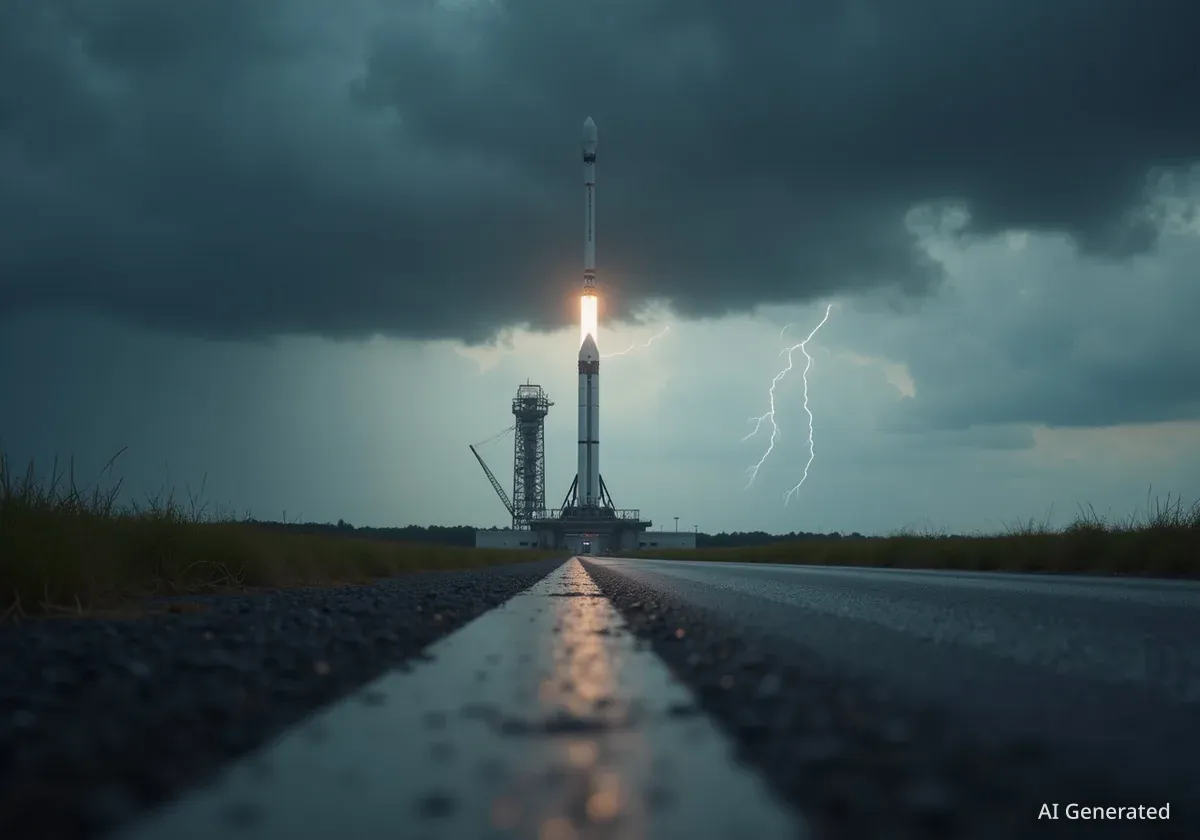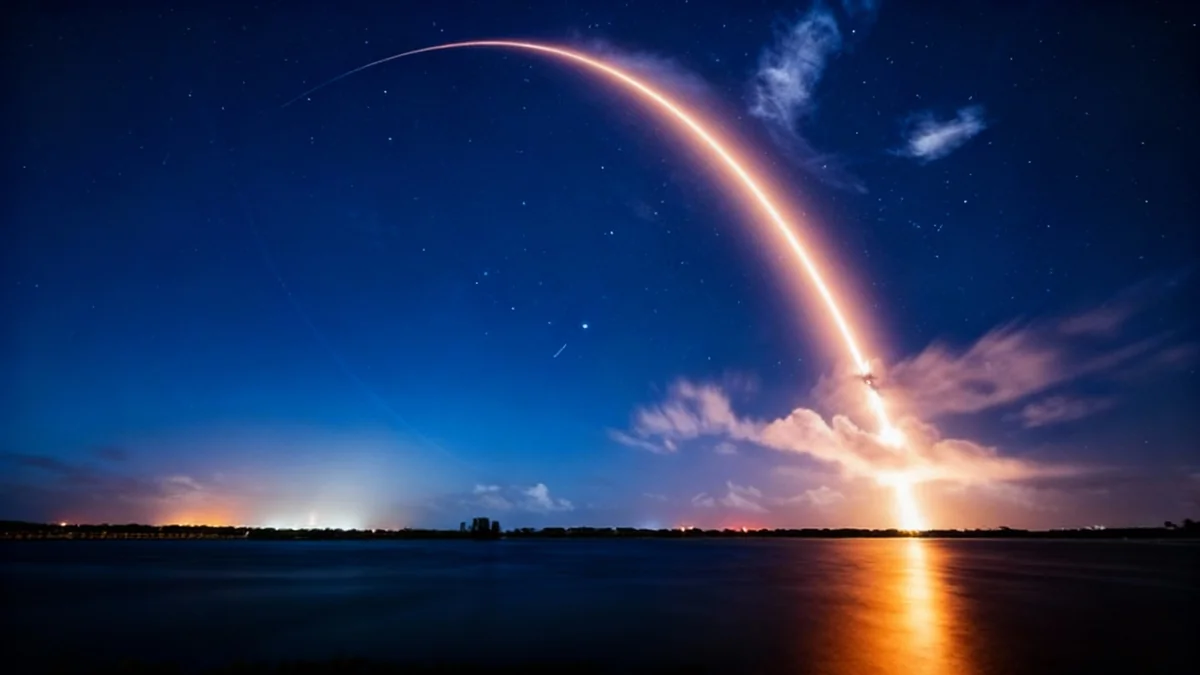SpaceX has postponed the launch of 24 Amazon Project Kuiper satellites, originally scheduled for Thursday, October 9, 2025. The delay is due to unfavorable weather conditions at the Cape Canaveral launch site. The mission is now scheduled to lift off no earlier than Saturday, October 11.
The mission, designated Kuiper Falcon 03 (KF-03), is a critical deployment for Amazon's growing broadband internet constellation. The decision to reschedule was made after forecasts predicted a low probability of acceptable weather for both launch and booster recovery operations.
Key Takeaways
- Mission Delay: The launch of 24 Amazon Kuiper satellites was moved from October 9 to October 11, 2025, due to poor weather.
- Weather Concerns: Forecasters cited a low-pressure system causing showers and instability, with only a 45% chance of favorable launch conditions.
- Payload: The Falcon 9 rocket carries 24 satellites, which will bring Amazon's Project Kuiper constellation to a total of 153 satellites in low Earth orbit.
- Booster Reuse: The mission uses Falcon 9 booster B1091 for its second flight, with a planned landing on the drone ship 'Just Read the Instructions'.
Weather Conditions Force Launch Reschedule
The primary factor behind the launch postponement was a challenging weather forecast for Florida's Space Coast. The 45th Weather Squadron, which provides meteorological support for launches, issued an outlook with only a 45% chance of favorable conditions during the original launch window on Thursday evening.
This represented a 10% decrease in favorability from the forecast issued just a day earlier. The outlook for Friday was not expected to show significant improvement, prompting the two-day delay to Saturday.
Meteorological Outlook
According to launch weather officers, a low-pressure system was developing near the Florida peninsula. This system was forecast to draw significant moisture from both the Atlantic Ocean and the Gulf of Mexico, creating an unstable atmosphere over the spaceport.
"With strong east-northeasterly flow and ample moisture from both the Atlantic and Gulf, expect enhanced, fast-moving shower activity Thursday evening with additional pulses generated from the low to the south," the official forecast stated.
These conditions not only affect the safety of the rocket during its ascent through the atmosphere but also pose a significant risk to the recovery of the Falcon 9's first-stage booster.
Booster Recovery Risk
Meteorologists classified the weather risk for the booster's autonomous drone ship landing as "high" on their low-medium-high scale. High seas and strong winds can prevent the drone ship from holding its position and jeopardize a successful landing.
Details of the Kuiper Falcon 03 Mission
The KF-03 mission is now targeted for liftoff from Space Launch Complex 40 (SLC-40) at Cape Canaveral Space Force Station. The new launch window opens on Saturday, October 11, at 8:41 p.m. EDT (0041 UTC).
Once launched, the Falcon 9 rocket will follow a north-easterly trajectory. This flight path is optimized to deliver the 24 Kuiper satellites into their designated low Earth orbit.
The satellite deployment sequence is a lengthy process scheduled to begin more than 56 minutes after liftoff. The entire deployment of the 24 satellites is expected to take less than eight minutes to complete, releasing them in stages to properly position them in orbit.
Falcon 9 Booster and Recovery Operations
This mission will utilize the Falcon 9 first-stage booster designated B1091. This will be the second flight for this particular piece of hardware. Its previous mission was also for Amazon, carrying the KF-02 satellite batch.
A Future Heavy Lifter
The booster B1091 is notable because it is slated to eventually be used as a core booster for SpaceX's more powerful Falcon Heavy rocket, which uses three Falcon 9 first stages strapped together.
Following stage separation, B1091 will perform a series of burns to reorient itself and target a landing on the autonomous drone ship, 'Just Read the Instructions,' stationed in the Atlantic Ocean. The landing is expected to occur approximately eight minutes after launch.
A successful landing would mark several milestones for SpaceX's reusable rocket program:
- The 138th successful landing on this specific drone ship.
- The 517th overall booster landing for SpaceX to date.
These numbers underscore the company's leadership in rocket reusability, a key factor in reducing the cost of access to space.
Amazon's Growing Satellite Constellation
The KF-03 mission is a significant step in the build-out of Amazon's Project Kuiper, a satellite network designed to provide global high-speed, low-latency broadband internet service. This launch will increase the number of Kuiper satellites in orbit to 153.
This flight is the sixth dedicated to the constellation. The previous five launches were split between United Launch Alliance's Atlas 5 rocket, which flew three missions, and SpaceX's Falcon 9, which has now been tasked with three.
SpaceX and Amazon Partnership
This launch marks the third and final mission under a contract Amazon announced with its competitor SpaceX in December 2023. The agreement was made to ensure timely deployment of its satellites as Amazon works to meet regulatory deadlines and begin service.
Project Kuiper is one of several large-scale satellite constellations, including SpaceX's own Starlink, aiming to connect underserved and remote areas of the world with reliable internet access. The successful deployment of these 24 satellites will move Amazon closer to activating its global network.





